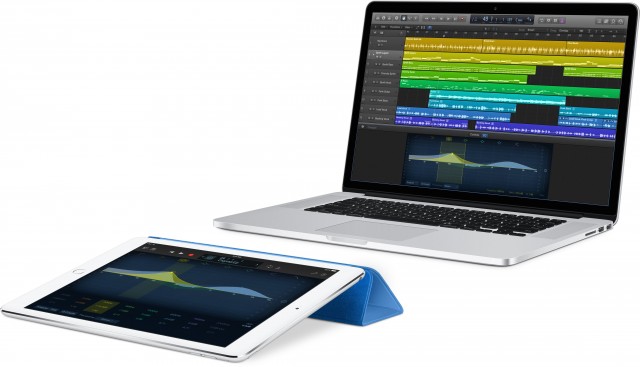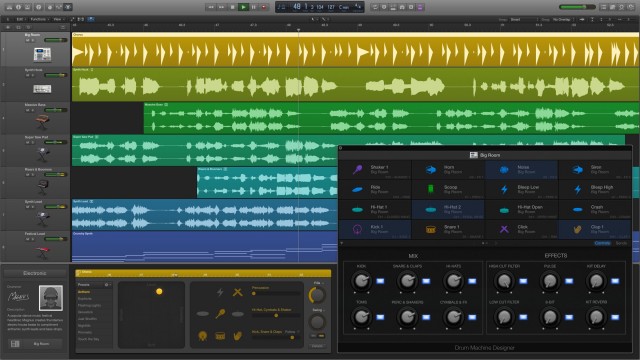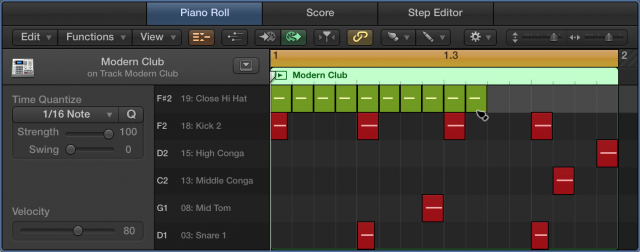With version number 10.1, the Logic Pro release out right now sounds like a “yawn, move along” bump. But there’s actually a big story here. Half that story is about making electronic beats. The other half, and maybe the more important half, is about editing. But let me explain.
Even with a steady stream of updates, I’m not convinced Logic Pro X has entirely shaken concerns from some hard-core producers about serious editing – whether they’re being fair or not. Something about all the cute graphics and loop browsing and GarageBand and iPad and iPhone seems to make them, well, nervous. It means they don’t always believe that word “Pro” attached to the name.
So, let me take you back to a time before Apple, when they felt differently. Remember when more people knew the acronym “IDM” than “EDM,” when the people building Logic were all still in gray, wet Hamburg, Germany instead of Cupertino, California?
In those days, the idea of Logic as a hard-core electronic music workstation was actually kind of a default. Sure, studio producers used Pro Tools, film composers used Digital Performer. But dance music was a rivalry between Logic and Cubase, as fierce as Hamburg SV versus St. Pauli.
Well, then Ableton Live and the American dance music boom happened, of course. But it’s still a Logic and Cubase battle. The difference is, now Logic seems to have a release that doesn’t seem to be trying to pander to guitarists or first-time producers or GarageBand updaters. They are, as always, implying you might use Logic to do the kind of studio work often associated in this industry with something rhyming with Mavid Glow Rules. But – heck, you might make some techno with it. Sorry, make that “EDM.”
Drum Machine Designer
The banner dance music feature here is a set of electronic drum production tools parallel to the assistants we’ve seen elsewhere in the program.
Drummer, initially touted as a way to make something sounding like a rock record happen automatically, now understands club music. There are styles like Techno and House, and yes, “Dubstep” and “Trap.” Like the rock drum pattern generation tools, Drum Machine Designer dynamically creates grooves, fills, and the like, which you can control via both Logic-supplied and user-generated parameter controls. Then, you can either use the pattern as-is, or convert them to a MIDI region for editing.
Under the hood, Logic is making drum sounds in the preset content the way it has for years – with the Ultrabeat synth/drum machine and EXS24 sampler. But this apparently isn’t just a bunch of pattern presets atop the old sounds. It’s more a way to get things rolling, or sketch ideas quickly, then get as detail-oriented and original as you want to finish your track. The sound synthesis tools (EXS and Ultrabeat) are the same, but on top of them is Logic Pro X’s new patch and Smart Controls, plus hundreds of new kit pieces for those engines.
It’s also possible to transform the sounds. You can mix and match patches from different kits, for instance. Also, if you prefer to use your own sounds – say, a drum synth – you can assign third-party plug-ins as well. The patterns and parts are routed to Track Stacks for sound generation, which you could assign to a plug-in or MIDI out to an iPad or whatever you desire.
This is of course really relevant to people who are Logic heads, because it means you can do all your production and pattern making without leaving Logic’s familiar track and arrangement workflow.
Whether this is useful to you or not depends on whether this sparks your creativity, but it could be worth a look. I’m going to try making some tracks this way soon.
Piano Roll Editing is Radically Improved
Finally. Even in 2015, MIDI editing is just a whole lot of what we do. But as Apple has gradually worked through the rest of Logic, brushing off dust and reworking tools, MIDI editing looks more or less like it always has. And other competitors (Cakewalk and Steinberg, for instance) haven’t stood still.
Well, finally we get something that might be worth the wait.
Brush Tool lets you use a single mouse gesture to make a sequence of notes. Drag across, and you can turn notes on – or turn them off. You set the rate (via a menu or key command), and even the quantization of the scale, and wherever you drag, you get notes. You can also right-click and turn selected notes into the active pattern for the brush.
In other words, this is, on one hand, the most powerful Black MIDI creating tool ever conceived. It is, on the other, probably useful for anyone who edits using a mouse, ever, and some who will now start.
(Cough, Hamburg – erm, Cupertino calling Berlin – this makes both Live and Maschine look comparatively stupid.)
Note Repeat, Spot Erase. Speaking of drum machines, you may not miss them when working in your DAW. You get Note Repeat and Spot Erase for real-time entry – without having to bring up dedicated drum machine software.
See Drum Sounds Names, Drag Time Handles. File this under: things you miss from other tools. Seeing the names of actual drum sounds rather than MIDI notes is something you’re familiar with if you work with Ableton Live, but now you can do it in Logic. And time handles – letting you manipulate notes’ time more easily – is something Logic was sorely lacking but has evidently added. That implementation now lets you compress or expand the selection of notes, to quickly do half, double time, triplet, or any arbitrary time expansion/compression of the MIDI performance. Changing the position of the handles also allows for reversing the order of select notes.
Quantize works the way you think. Okay, you know how this goes: the moment you quantize a live performance, you destroy everything. Smart Quantize proportionally corrects timing and length based on some intelligent identification of both rhythmic content and velocity (more heavily weighting louder notes – the important stuff, that isn’t flams or mistakes). Sounds great; can’t wait to try it.
A better Compressor. Retina interface, plus a view that lets you monitor historical levels instead of looking at VUs. And a new Classic VCA compressor model (curious how that sounds, as I had mostly stopped using Logic’s compressor).
Here’s the more traditional Classic VCA UI:
Retro Synth with wavetable features. Ah, now this is cool: drag and drop audio and Retro Synth creates wavetables. That alone is reason to fire up Logic if you haven’t lately. You can also stack up eight voices.
New sounds. So, Apple has done a lot with their audio content and in particular has built on top of engines like EXS to provide more sophisticated presets that use various Logic features. This content uses a combination of Patches, Track Stacks, MIDI Plug-Ins, and Smart Controls to create more dynamic, layered presets. There are hundreds of new patches to take advantage of that, with 200 synth patches and 10 (interestingly enough) Mellotron instruments. (Wonder whose pet project that was?)
Automation by region. Automate effects creatively on a region and not just a track – that’s huge as a tool if you use effects heavily in sound design.
(See above! Yes! Okay, only a few people shout for this sort of thing, but – let’s shout together, you and the three other of us!)
Relative and Trim Automation. Ugh. Finally. I’d explain this, but those of you who are used to mixing this way are already sold.
Plug-in organization! Yes! Sorry, I got excited.
Wouldn’t it be great if Logic didn’t just dump your entire Audio Unit plug-in library into a menu you can’t navigate? Fixed. Organize it like you like.
Wouldn’t it be great if you could also reorder and enable/disable plug-ins from the iPad? Fixed. (You can also get into parameters, but we’ll see how useful that is in practice – testing.)
Multi-touch EQ support from the iPad. No brainer. Finally. (Actually, didn’t I beg them for this in the review? Probably me and everyone else who picked up the iPad app!)
And more:
• Manage large-scale mixes more easily with the addition of console-style VCA faders
• Mixer now allows remote control of microphone and other input settings for compatible audio interfaces
• Realtime rendering of fades allow them to work with Flex Pitch and speeds up project load times
• Support for Mail Drop and Air Drop in OS X Yosemite makes it even easier to share your Logic projects
And of course MainStage (the live app) and Logic Remote (the iPad control app) get parallel updates.
It’s all free; it’s all now on the App Store. Have at it, Logic users.
I’ll review relevant functionality as far as drum tracks, and introduce you to the Logic production that will make me headline in Las Vegas (just kidding) soon.
Updated: version requirements, changelog
Logic 10.1 requires OS X 10.9 (Mavericks) or greater. Par for the course with Apple. But this means it will appear as an “incompatible update” if you’re running 10.8. (Though, frankly, if you’re running 10.8 happily I think 10.10 will treat you just fine. And if you want more OS backwards compatibility, maybe you don’t want Logic.)
And the change:
Logic 10.1 Release Notes [Apple Support]
AUganizer
Various complaints from people who bought the Mac utility AUganizer to perform the AU organizing functions now baked into Logic. However, there are reasons not to sweat this – like support for hosts other than Logic and OS support prior to 10.9.
And the whole utility has loads of other features: Cover Flow previews, backup, sharing lists with other users, working with changes and updates, and so on. I just wish it supported VSTs and had more robust support for some other hosts. (Ableton? Cubase?)
In fact, I suspect someone out there (like me, for instance) may wind up discovering this utility because of the present discussion.





